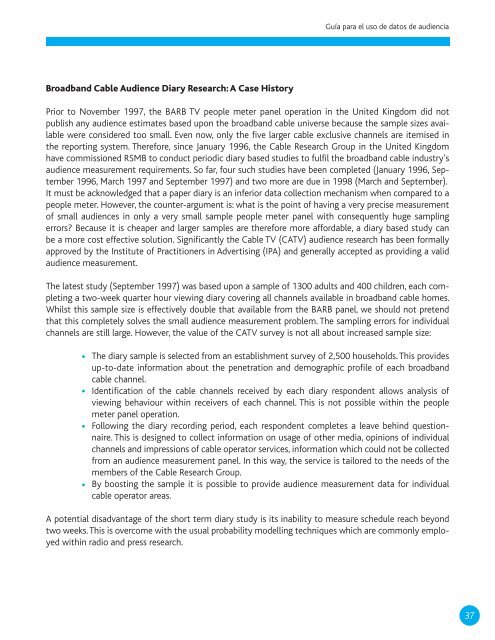Guía para el uso de datos de audiencia Nielsen IBOPE México
Guía para el uso de datos de audiencia Nielsen IBOPE México
Guía para el uso de datos de audiencia Nielsen IBOPE México
You also want an ePaper? Increase the reach of your titles
YUMPU automatically turns print PDFs into web optimized ePapers that Google loves.
Broadband Cable Audience Diary Research: A Case History<br />
<strong>Guía</strong> <strong>para</strong> <strong>el</strong> <strong>uso</strong> <strong>de</strong> <strong>datos</strong> <strong>de</strong> <strong>audiencia</strong><br />
Prior to November 1997, the BARB TV people meter pan<strong>el</strong> operation in the United Kingdom did not<br />
publish any audience estimates based upon the broadband cable universe because the sample sizes available<br />
were consi<strong>de</strong>red too small. Even now, only the five larger cable exclusive chann<strong>el</strong>s are itemised in<br />
the reporting system. Therefore, since January 1996, the Cable Research Group in the United Kingdom<br />
have commissioned RSMB to conduct periodic diary based studies to fulfil the broadband cable industry’s<br />
audience measurement requirements. So far, four such studies have been completed (January 1996, September<br />
1996, March 1997 and September 1997) and two more are due in 1998 (March and September).<br />
It must be acknowledged that a paper diary is an inferior data collection mechanism when compared to a<br />
people meter. However, the counter-argument is: what is the point of having a very precise measurement<br />
of small audiences in only a very small sample people meter pan<strong>el</strong> with consequently huge sampling<br />
errors? Because it is cheaper and larger samples are therefore more affordable, a diary based study can<br />
be a more cost effective solution. Significantly the Cable TV (CATV) audience research has been formally<br />
approved by the Institute of Practitioners in Advertising (IPA) and generally accepted as providing a valid<br />
audience measurement.<br />
The latest study (September 1997) was based upon a sample of 1300 adults and 400 children, each completing<br />
a two-week quarter hour viewing diary covering all chann<strong>el</strong>s available in broadband cable homes.<br />
Whilst this sample size is effectiv<strong>el</strong>y double that available from the BARB pan<strong>el</strong>, we should not pretend<br />
that this complet<strong>el</strong>y solves the small audience measurement problem. The sampling errors for individual<br />
chann<strong>el</strong>s are still large. However, the value of the CATV survey is not all about increased sample size:<br />
The diary sample is s<strong>el</strong>ected from an establishment survey of 2,500 households. This provi<strong>de</strong>s<br />
up-to-date information about the penetration and <strong>de</strong>mographic profile of each broadband<br />
cable chann<strong>el</strong>.<br />
I<strong>de</strong>ntification of the cable chann<strong>el</strong>s received by each diary respon<strong>de</strong>nt allows analysis of<br />
viewing behaviour within receivers of each chann<strong>el</strong>. This is not possible within the people<br />
meter pan<strong>el</strong> operation.<br />
Following the diary recording period, each respon<strong>de</strong>nt completes a leave behind questionnaire.<br />
This is <strong>de</strong>signed to collect information on usage of other media, opinions of individual<br />
chann<strong>el</strong>s and impressions of cable operator services, information which could not be collected<br />
from an audience measurement pan<strong>el</strong>. In this way, the service is tailored to the needs of the<br />
members of the Cable Research Group.<br />
By boosting the sample it is possible to provi<strong>de</strong> audience measurement data for individual<br />
cable operator areas.<br />
A potential disadvantage of the short term diary study is its inability to measure schedule reach beyond<br />
two weeks. This is overcome with the usual probability mod<strong>el</strong>ling techniques which are commonly employed<br />
within radio and press research.<br />
37


